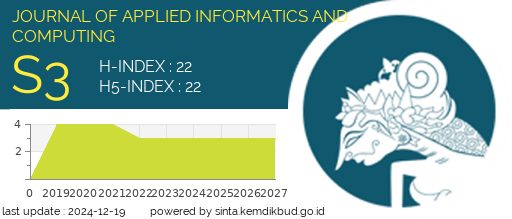IoT-Based Smoking Violation Detection System Equipped with Object Detection Using YOLOv5s Algorithm
DOI:
https://doi.org/10.30871/jaic.v9i3.8459Keywords:
MQ-7, MQ-135, Smoking Violation Detection System, Telegram, YOLOv5sAbstract
Smoking is a common habit in Indonesia. The Indonesian government has implemented regulations on smoke-free areas, but violations of the smoke-free policy still often occur. Previous studies have developed smoking violation detection system based on the MQ sensor. However, the smoking violation detection system based only on the MQ sensor is less reliable because the detected gas could come from other sources. Therefore, this study discusses a smoking violation detection system that can automatically verify smoking violation activities using the MQ-7 sensor, MQ-135 sensor, and the YOLOv5s algorithm. The MQ-7 sensor that has been calibrated to detect CO in ppm units achieved an accuracy level of 89.84%. The MQ-135 sensor also has successfully detected ammonia and toluene in cigarette smoke in ppm units. The trained YOLOv5s algorithm achieved an average Precision of 91.9%, Recall 83.7%, F1-Score 87.6%, and mAP50 88.3%. The system is equipped with a speaker that will sound automatically after a verified smoking violation occurs and Telegram notifications in the form of text messages and images.
Downloads
References
[1] S. R. Johnson, “These 20 Countries Have the Highest Tobacco Smoking Rates,” U.S. News World & Report, 2023. https://www.usnews.com/news/best-countries/slideshows/countries-with-the-highest-smoking-rates?onepage (accessed Mar. 08, 2024).
[2] National Cancer Institute, “Harms of Cigarette Smoking and Health Benefits of Quitting,” 2017. https://www.cancer.gov/about-cancer/causes-prevention/risk/tobacco/cessation-fact-sheet (accessed Mar. 08, 2024).
[3] World Health Organization, “Tobacco,” 2023. https://www.who.int/news-room/fact-sheets/detail/tobacco (accessed Mar. 08, 2024).
[4] Pemerintah Republik Indonesia, “Undang-Undang Republik Indonesia Nomor 17 Tahun 2023 Tentang Kesehatan,” Undang-Undang, no. 187315, pp. 1–300, 2023.
[5] S. Ramachandran, S. Bentley, E. Casey, and J. P. Bentley, “Prevalence of and Factors Associated with Violations of A Campus Smoke-Free Policy: A Cross-Sectional Survey of Undergraduate Students on A University Campus in the USA,” BMJ Open, vol. 10, no. 3, pp. 1–10, 2020, doi: 10.1136/bmjopen-2019-030504.
[6] M. A. Buchari et al., “E-WS: A Novel Smart Information System Towards Smokers for the Outdoor Canteen Environment,” vol. 172, no. Siconian 2019, pp. 289–293, 2020, doi: 10.2991/aisr.k.200424.043.
[7] S. Kumar, Palnatijayaram, M. Pavan, and P. Lokesh, “No Smoking Zone Monitoring & Alerting System,” vol. 12, no. 3, pp. 18–25, 2023.
[8] F. H. Mahdalena, N. Firmawati, and R. Rasyid, “Rancang Bangun Sistem Monitoring Asap Rokok di Toilet Sekolah Menggunakan Sensor MQ-7 dan Transceiver nRF24L01+ dengan Output Suara Berbasis Modul ISD 1820,” Nat. Sci., vol. 6, no. 2, pp. 144–150, 2020, [Online]. Available: https://ejournal.uinib.ac.id/jurnal/index.php/naturalscience/article/view/1703.
[9] M. Badrudin, A. Izzuddin, and A. Analisa R, “Rancang Bangun Sistem Peringatan Larangan Merokok Menggunakan Output Rekaman Suara Berbasis Arduino,” J. Sos. Teknol., vol. 1, no. 12, pp. 622–631, 2021, doi: 10.59188/jurnalsostech.v1i12.273.
[10] S. G. Muqita, W. Indrasari, H. Suhendar, and M. A. Marpaung, “Karakterisasi Dan Pengujian Sensor Mq-7 Dan Mq-136 Untuk Pengembangan Sistem Monitoring Konsentrasi Gas Karbon Monoksida (Co) Dan Sulfur Dioksida (So2),” vol. XII, pp. 87–92, 2024, doi: 10.21009/03.1201.fa13.
[11] Y. R. Carrillo-Amado, M. A. Califa-Urquiza, and J. A. Ramón-Valencia, “Calibration and Standardization of Air Quality Measurements Using MQ Sensors,” Respuestas, vol. 25, no. 1, pp. 70–77, 2020, doi: 10.22463/0122820x.2408.
[12] I. Kandel and M. Castelli, “The effect of batch size on the generalizability of the convolutional neural networks on a histopathology dataset,” ICT Express, vol. 6, no. 4, pp. 312–315, 2020, doi: 10.1016/j.icte.2020.04.010.
[13] A. I. Karisma, F. Kurniawan, and A. Hanani, “Rancang Bangun Sistem Monitoring Environment Area Tempat Tinggal Mahasiswa Berbasis IoT,” Matics, vol. 11, no. 2, pp. 51–55, 2019, doi: 10.18860/mat.v11i2.8416.
[14] National Academies of Sciences Engineering and Medicine, Health and Medicine Division, Board on Population Health and Public Health Practice, and Committee on the Review of the Health Effects of Electronic Nicotine Delivery Systems, “Toxicology of E-Cigarette Constituents,” in Public Health Consequences of E-Cigarettes, D. L. Eaton, L. Y. Kwan, and K. Stratton, Eds. Washington (DC): National Academies Press (US), 2018.
[15] A. Tasnim, M. Saiduzzaman, M. A. Rahman, J. Akhter, and A. S. M. M. Rahaman, “Performance Evaluation of Multiple Classifiers for Predicting Fake News,” J. Comput. Commun., vol. 10, no. 09, pp. 1–21, 2022, doi: 10.4236/jcc.2022.109001.
[16] S. A. Hicks et al., “On evaluation metrics for medical applications of artificial intelligence,” Sci. Rep., vol. 12, no. 1, pp. 1–9, 2022, doi: 10.1038/s41598-022-09954-8.
[17] R. Padilla, S. L. Netto, and E. A. B. Silva, “Proceedings of the 2020 International Conference on Systems, Signals and Image Processing, IWSSIP 2020,” Int. Conf. Syst. Signals, Image Process., vol. 2020-July, pp. 237–242, 2020
Downloads
Published
How to Cite
Issue
Section
License
Copyright (c) 2025 Audina Amalia Putri, Indra Hermawan

This work is licensed under a Creative Commons Attribution-ShareAlike 4.0 International License.
Authors who publish with this journal agree to the following terms:
- Authors retain copyright and grant the journal right of first publication with the work simultaneously licensed under a Creative Commons Attribution License (Attribution-ShareAlike 4.0 International (CC BY-SA 4.0) ) that allows others to share the work with an acknowledgement of the work's authorship and initial publication in this journal.
- Authors are able to enter into separate, additional contractual arrangements for the non-exclusive distribution of the journal's published version of the work (e.g., post it to an institutional repository or publish it in a book), with an acknowledgement of its initial publication in this journal.
- Authors are permitted and encouraged to post their work online (e.g., in institutional repositories or on their website) prior to and during the submission process, as it can lead to productive exchanges, as well as earlier and greater citation of published work (See The Effect of Open Access).











